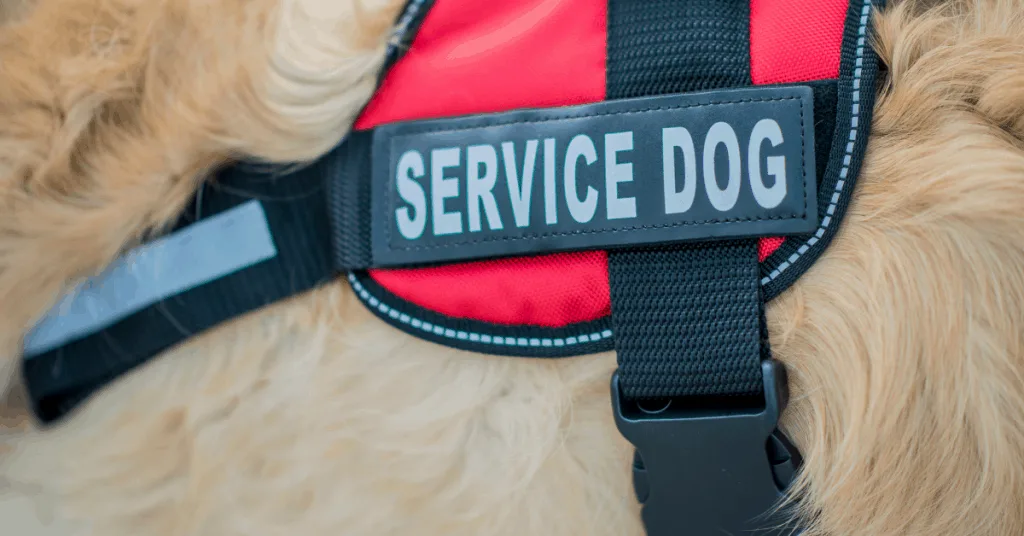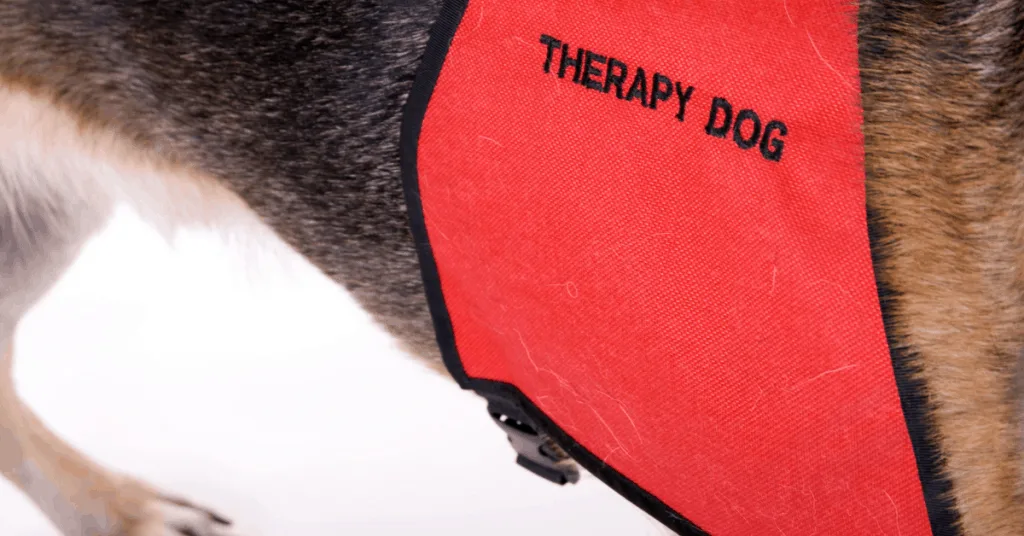
German Shepherds are one of the most popular dog breeds in the world.
In fact, the GSD ranked second as the most popular dog breed based on the 2019 registration statistics of the American Kennel Club.
But despite their popularity, are German Shepherds good emotional support dogs as well?
German Shepherds possess multiple characteristics that make them very well suited to be emotional support dogs. These characteristics include:
- They are extremely loyal
- They are highly intelligent
- They are great family dogs
- They are intuitively protective
- They are great around children
- They possess a calm temperament
- They possess a high degree of trainability
- They are highly sensitive to their owner’s emotional needs
Because of these characteristics, many people with disabilities who are looking for emotional support dogs turn to German Shepherds.
If you are considering a German Shepherd as an emotional support dog, here is everything you need to know.
Click Here to Jump to a Section
What are Emotional Support Animals (ESAs)?
An emotional support animal (or ESA) is any pet (usually a dog or a cat, but other animals can also qualify) that provides emotional support and companionship to its owner daily.
An ESA is especially helpful for people living with certain mental illnesses such as anxiety and depression.
Having an emotional support animal comes with certain legal protections, although not as many as having a service dog.
What’s the Difference Between Service, Therapy, & Emotional Support Dogs?
Whenever you see a dog in a vest, it is easy to assume it’s a service dog or a therapy dog.
You may think that a dog assisting a blind person and another that visits a nursing home fall under the same category.
However, these dogs have different duties, responsibilities, and rights, thus it’s important to distinguish them from one another.
Service Dogs

A service dog is a dog that is specially trained to carry out tasks for people with certain disabilities such as visual, hearing, and mobility impairments as well as conditions like diabetes, psychiatric disorders, and seizure disorders.
They allow their handlers to experience a more independent and comfortable life by making things easier for them.
Because they need to be focused on their handlers, service dogs are trained not to be distracted by other things and people.
Important note: Never pet an ESA out of excitement, not matter how friendly they may seem. These animals are performing a job. Always ask the handler first if the dog can be approached!
Due to these serious responsibilities, the American with Disabilities Act (ADA) categorizes service dogs as working dogs, not pets.
The ADA does not require that a service dog be trained by a professional trainer only. The PWD (person with a disability) handler has the right to train the dog as well.
There are many types of service dogs:
- The most popular is the guide dog, or the seeing eye dog. As the moniker implies, guide dogs lead people with visual impairments along their path.
Labrador Retrievers, Labrador-Golden Retriever mixes, and German Shepherds are the most common dog breeds for this role. This is because they are very reliable, easy to handle, and gentle. - Hearing dogs assist deaf or hard-of-hearing individuals by alerting them through touch whenever they hear an alerting sound such as doorbells, fire alarms, a whistling kettle, cellphone calls, and crying babies.
Labradors and German Shepherds are popularly used as hearing dogs, but smaller breeds like Terriers, Cocker Spaniels, Lhasa Apsos, and even Chihuahuas are also trained for this job. - Another type of service dogs are mobility assistance dogs, or those who help individuals with mobility issues.
These dogs aid by acting as a brace, getting objects for their handlers, pressing elevator buttons, pulling wheelchairs on ramps, and several other tasks specifically needed by the PWD.
Because some of these tasks require physical strength, larger breeds such as GSDs and Retrievers are often chosen for this work.
People who may benefit from mobility assistance dogs are those with spinal injuries and arthritis, among others. - Diabetic alert dogs can smell chemical changes in a human that signal either a rise or a drop in blood sugar.
This alerts the person to test his blood and thus perform necessary actions such as injecting himself with insulin or ingesting glucose to prevent his blood sugar levels from becoming dangerous. - Psychiatric service dogs assist people with psychiatric disorders such as depression, anxiety, and post-traumatic stress disorder (PTSD).
People with the latter, often military veterans who acquired the condition due to prolonged exposure to war, benefit mostly from these dogs.
A PTSD sufferer is abnormally sensitive to stress and places which may trigger flashbacks. A service dog provides security by making sure that a place is safe to enter.
In crowded areas, the dog also adds some personal space around the handler by acting as a barrier.
The mere presence of the dog also provides comfort and security. - Autism assistance dogs are often seen with children. These dogs give autistic people independence, safety, and security, allowing for a more normal experience of life.
Importantly, they take orders from the parents, not the children.
Autism assistance dogs make sure that the kids do not wander unsupervised and alert the parents of dangerous situations. - Seizure response dogs are dogs that are trained to do specific tasks once a seizure happens in a person with epilepsy.
They may alert other people in the house about a seizure episode, get the phone or medicine, wake the person up, or remove the person from unsafe situations.
Handlers of service animals enjoy specific rights as mandated by the law.
Service dogs can enter public places like hospitals, business establishments like movie theaters and restaurants.
Even in locations with a “no pets” policy, a service dog cannot be denied entry.
They are allowed access to public transportation vehicles that enforce the “no-pets” policy., and they are also permitted to accommodate their handler in air travel.
Therapy Dogs

Therapy dogs are often found in places such as nursing homes, hospices, hospitals, trauma centers, and rehabilitation centers.
They provide relief and companionship to the sick, elderly, and people who are healing from psychological trauma such as disaster and abuse survivors.
Therapy dogs are classified into three types:
- Therapeutic visitation dogs are normally household pets. Their owners take them regularly to hospices, hospitals, and nursing homes to provide comfort and relief to patients.
- Animal-assisted therapy dogs are trained to help people with physical injuries or mobility issues recover their motor skills by taking part in activities and games.
- Facility therapy dogs are usually in-house dogs with handlers who provide comfort and affection to people with cognitive illnesses such as Alzheimer’s disease, dementia, and others.
Unlike service dogs, therapy dogs do not enjoy any special rights. This is because they are still classified as pets, and they cater to multiple persons instead of an individual handler.
Emotional Support Dogs
Emotional support dogs provide daily comfort and companionship to people with psychological and emotional disabilities.
Unlike service dogs, emotional support dogs are not required by law to be specially trained to carry out specific tasks for their owner.
Rather, their mere presence is the source of comfort and security.
Because of this distinction, emotional support dogs are protected by fewer laws than service dogs.
ESAs are not allowed to enter public places or public transportation that have a no-pets policy.
Unlike therapy dogs, however, emotional support dogs are protected by the Fair Housing Act (FHA) and the Air Carrier Access Act.
This means that:
- The owner of the emotional support dog cannot be prohibited from renting an otherwise no-pets apartment.
- The dog can accompany her owner during air travel.
What Traits Make a Good Emotional Support Dog?

Not all dogs make good emotional support dogs. There are certain traits that make a dog more suitable for the role than others.
To be an effective emotional support dog, the following traits are must haves:
- Calm and gentle: If you’re suffering from low energy, a dog with a more calm temperament might be more suitable for you than one who is always excitable and running around.
- Loyal: A loyal dog who sticks with and is willing to please you is an ideal emotional support companion.
- Friendly: A friendly dog is just a joy to be with. Since you will be taking her to places with you, it’s essential that she’s also friendly to strangers and other animals, too.
- Obedient: An emotional support dog must know how to obey basic commands.
- Consistent: Your dog must be consistently well-behaved especially when you’re out in public and on flights.
Unpredictable behavior may indicate that you probably cannot rely on your companion in adverse situations. - Attentive: An attentive dog will be more attuned to your needs than one who has the tendency to be aloof.
- Patient and affectionate: Some dogs just don’t like being showered with too much attention.
If you think you’d want to cuddle your dog for hours, she must be okay with receiving affection!
It will also be more rewarding for you if your dog is the type who gives affection in return.
How Can You Benefit from an Emotional Support Dog?
Anybody can benefit from the warmth and companionship that dogs offer. That’s why we have pets!
However, having an emotional support dog brings with it some rights that are protected under federal laws that are otherwise not granted to household pets.
Below are several ways that an emotional support dog might be able to help you:
- ESA’s relieve loneliness: In the U.S. alone, three out of five Americans reported feeling lonely, according to a recent survey released this year.
If you suffer from depression, these feelings of loneliness can be magnified to the point of becoming debilitating. Just ask anyone who suffers from it.
The presence of an affectionate emotional support dog can curtail the effects of loneliness – this claim is backed by numerous studies.
A properly socialized dog can also facilitate the formation of new relationships with humans as you go out for a walk. - ESA’s provide Stress relief: Aside from feeling lonely, Americans also reported to be among the most stressed people in the world, according to a recent poll.
Having a mental illness or anxiety disorder can make you even more prone to becoming overwhelmed by stress.
An emotional support dog by your side can help relieve stress by giving you a much-needed break from your thoughts. - ESA’s provide a sense of security: It’s essential for everyone to feel a sense of security inside and outside their house.
For people living with anxiety and mental disorders, this feeling of security may be hard to come by.
The presence of an emotional support dog can provide just that.
This is especially helpful for PTSD sufferers who are easily triggered by crowded areas and closed spaces. The right dog can make her owner feel safe by acting as a “shield” against other people. - ESA’s provide motivation for fitness: If your emotional support dog is a German Shepherd, you must exercise her daily.
This can provide you and your dog the opportunity to exercise together, which is a win-win situation.
Physical activity has long been proven to benefit mental health. - ESA’s provide anxiety relief: An emotional support dog can help a person become grounded in moments of intense anxiety.
Deep Pressure Therapy
In addition, an ESA can also be trained to to perform Deep Pressure Therapy on you whenever an anxiety or panic attack occurs.
Smaller dogs can use their entire weight, while bigger dogs like GSDs can use their head or their paws to press on your stomach or chest while you’re lying down.
This additional command is well worth the time spent training your dog, as knowing that you can rely on her to feel better during terrifying anxiety episodes is priceless!
Check out this video of a GSD service dog performing DPT techniques on simulated anxiety attacks – pretty amazing!
What Are the Best Dog Breeds for Emotional Support?
Because of the necessity of the characteristics mentioned above, some breeds naturally make better emotional support dogs than others.
- Retriever-type dogs like Labrador Retrievers and Golden Retrievers are excellent dog breeds that perform the emotional support role.
They are naturally gentle, calm, intelligent, obedient, and very friendly to other people and animals.
These people-oriented breeds are very affectionate and attentive to their human companions.
Keep in mind, however, that these large breeds require lots of exercise, so if your condition limits you from exercising your dog, it might be better to get a smaller breed.
These dogs also require spacious areas for playing and wandering, so they’re more suitable for people with large backyards or garden lots.
- Border collies are medium-sized dogs which can also be ideal for emotional support.
These incredibly smart and happy dogs are highly trainable and eager to please their owners. As herding dogs, they are natural in protecting not just sheep but also humans.
Border Collies are also highly sensitive; they can pick up subtle changes in the environment and in a person’s body language.
Like the Retrievers, these active dogs require daily exercise. Their high energy will inspire you to get up and moving – perfect if you’d like to motivate yourself to get some physical activity.
- Bully breeds, more commonly known as “pit bulls,” make good emotional support dogs, too.
Despite the bad rap they get for being aggressive dogs, they are, in fact, very gentle to humans if raised in a loving environment.
However, if you have other pets at home, you need to consider that some pit bulls tend to be selective with their behavior around other animals.
But with proper training and socialization from an early age, they can live peacefully with other pets.
Sadly, some states enforce breed-specific legislation laws that prohibit their citizens from owning bullies.
This law is overridden by the FHA (a federal law), but it’s good practice to check with your state’s laws first before getting a pit bull to avoid complications in the future.
- On the smaller side of the scale, Yorkshire Terriers make terrific emotional support dogs.
These little loving dogs have very good temperament and are friendly to other people and animals. Their small size also makes them an ideal candidate for those living in smaller apartments or houses.
Yorkshire Terriers can easily be carried anywhere, and they make perfect lap dogs.
Unlike bigger dogs, they require very minimal exercise. Yorkies love getting lots of affection, so if you would like an emotional support dog that doesn’t mind being held and cuddled, a Yorkie would work well for you!
- Corgis are also wonderful emotional support dogs. They are obedient, highly intelligent, very affectionate, not to mention cute!
Bred originally as herding dogs, these energetic dogs require plenty of exercise daily. - Despite their unpredictable temperament, Chihuahuas can be good emotional support dogs.
However, they are more fitting for reclusive handlers since they tend to be wary of other people and animals.
These tiny dogs have very fragile bones, too, so rambunctious children in the house may accidentally hurt them.
Generally speaking, Chihuahuas are very loyal, low-maintenance dogs who find contentment in staying inside the house with their human.
Are German Shepherds Good Emotional Support Dogs?

There is a reason why many vested dogs that you see in public are German Shepherds – they are an excellent choice for service and therapy roles.
Their high degree of intelligence and natural inclination to protect are often utilized to assist people with a wide range of needs.
GSDs make outstanding emotional support companions for the same reasons that they excel in service roles.
As natural guard dogs, they are incredibly loyal to their owner, bringing a sense of security, especially for people living alone and those who suffer from PTSD.
Their powerful and unmistakable presence alone is enough to keep someone grounded and help battle feelings of loneliness.
But don’t be fooled by their intimidating appearance! GSDs are sweet and affectionate by nature which makes them perfect life companions.
GSDs are also great with children if trained properly. So if you have kids in the house, a German Shepherd can allow you to have more time for yourself.
Important note: Keep in mind that while GSDs can “babysit,” it is important that you don’t leave your GSD alone with children without knowing first your pet’s full tendencies around them.
As naturally very smart and obedient dogs, German Shepherds can be trained to behave well inside and outside the house.
This makes them easy to manage wherever you go, including airplanes and apartments with strict pet policies.
German Shepherds can also be trained to respond appropriately to people with anxiety and panic disorders.
Anyone who has experienced one or both of these can attest to just how traumatic these occurrences can be.
Having an appropriately trained GSD by your side can help to reduce or even eliminate these episodes altogether.
Additionally, because GSDs are sturdy and intelligent dogs, they adapt well to changing environments.
For example, if you decide to move, you can rest assured that your GSD will adapt well to her new home.
This adaptability is also one of the reasons German Shepherds are employed in various fields, from dangerous jobs such as police and military work to less intense workplaces like nursing homes and hospitals.
Lastly, the high energy of German Shepherds can benefit a person suffering from mood disorders.
Since GSDs need plenty of physical activity, this responsibility can become a shared opportunity for both the dog and the depressed owner to reap the benefits of exercise.
Things to Consider Before Getting a German Shepherd as an Emotional Support Dog
Although German Shepherds can be amazing emotional support animals, they are not for everyone.
GSDs are bred as working dogs, so they thrive in always having a job to do.
This means that exercise and mentally-stimulating activities are a must if you want to keep your GSD entertained.
Otherwise, she will eventually become bored, which may result in wreaking havoc around the house.
If your condition keeps you from exercising your dog daily, perhaps another breed will be more beneficial to you.
German Shepherds also need to be properly socialized, ideally starting at an early age.
While all dogs require proper socialization, this is a must for GSDs – no exceptions.
Unsocialized, a GSD may become aggressive to other dogs and even humans – something that must absolutely be avoided when dealing with a dog as powerful and potentially dangerous as a German Shepherd.
Consider that it can be quite challenging for a dog owner with depression to muster the energy to train a German Shepherd.
On the other hand, this challenge can turn into an opportunity to take responsibility for something other than one’s self, or even become a source of fulfillment, which is good for mental health.
Does Size Matter?

Animals of all sizes can become a source of emotional support. But sometimes, the size of an animal should be considered for the following reasons:
- Space: If you live in a small apartment or house that doesn’t have enough room for the dog to stretch her legs, it may not be ideal to get a German Shepherd.
It can still work, though, if there are places nearby where you can take her for a walk.
For more detailed information about keeping a GSD in an apartment, take a look at this informative article:
Can a German Shepherd Live in an Apartment? - Food expenses: GSDs eat more food than smaller dogs, which means that you’ll need to spend more money because you will need to buy larger quantities of food more frequently than with a smaller breed.
- Manageability: GSDs are huge and powerful dogs. If untrained on a leash, they can easily pull you off balance. An excited German Shepherd who jumps on you can also knock you down.
If your condition limits your physical strength or mobility to handle these situations, a GSD may not be for you.
Of course, these inconveniences can be resolved if the dog has been properly trained. - Health issues: Large breeds like Retrievers and German Shepherds have a high potential for affliction with a host of health issues not commonly found in small breeds, such as arthritis, hip and elbow dysplasia, bloat, and cancer.
- Life span: Sadly, big dogs generally have a shorter lifespan than small dogs.
On average, a German Shepherd can live for up to 9-13 years, which is on the middle to higher end of life expectancy rate in dogs.
On the other hand, many Chihuahuas and Dachshunds live past 15 years of age! Of course, many factors can affect a dog’s life expectancy.
Proper diet and exercise can increase the chances of your GSD living a long life.
Small Breeds
Small breeds, in general, have certain advantages over larger breeds in being emotional support dogs.
- Their size makes them more manageable to carry around, a feat that is particularly helpful for mobility impaired owners.
- They are also more likely to be approved for air travel since they don’t take up much space.
- Similarly, they are more likely to be allowed by landlords in small apartments or houses.
- Smaller breeds are also more economical because they eat less food, and, unlike big dogs, they do not require as much exercise.
When all things have been considered, sometimes it boils down to personal preference.
Some people prefer bigger dogs for their commanding presence, while others prefer the smaller ones for their lapdog characteristics.
How Can You Apply to Have an Emotional Support Dog?
Fortunately, it’s easy to apply to have an emotional support dog.
You only need an ESA letter from a licensed mental health professional (LMHP) who will then recommend you qualify for access to an ESA.
What Ailments or Disabilities Can Qualify You for Getting an Emotional Support Dog?
To qualify for an ESA, your condition or disability must be listed under the Diagnostic and Statistical Manual of Mental Disorders Fifth Edition (DSM-5).
People with the following mental health disorders or impairments can qualify for an ESA:
- Anxiety disorders (General Anxiety Disorder, Separation Anxiety Disorder, Social Anxiety Disorder)
- PTSD
- Bipolar Disorder
- Depression
- Chronic stress
- Attention Deficit Disorder
- Autism
- Cognitive disorders or age-related cognitive decline
- Learning disabilities
- Schizophrenia
- Obsessive-Compulsive Disorder
Keep in mind that your family doctor or any other general practitioner is NOT qualified to give this assessment.
Only licensed mental health professionals like psychologists, therapists, and psychiatrists can give you an ESA letter!
This is important since landowners and airline companies will reject your letter otherwise.
If your ESA letter is invalid, you will not be protected under the law.
Spotting a Genuine ESA Letter
Several illegitimate websites have sprouted in the past years offering fake ESA letters to unknowing applicants.
Make sure that your ESA letter is genuine to prevent future troubles with property owners and cabin crew, as misrepresenting your dog as an ESA (even if unintentional) with a fake letter can cost you up to $125,000 or even jail time!
The safest way to acquire a genuine ESA letter is to follow the traditional route: contact your current mental health professional and ask if they can provide you one.
It’s important that this LMHP is your current doctor so that he or she can give the proper and current assessment of your condition.
Alternatively, you can get an ESA letter online.
Note that the websites themselves do not issue the letters; rather, they set you up with an LMHP who will then assess you and write you the letter.
Should you take this route, you need to be extra vigilant about the website’s legitimacy.
It is helpful to ask request that the website show you authenticity documents or even a sample ESA letter.
If they refuse or otherwise cannot provide you with one or both of these, then it’s best to move on.
To spot a genuine ESA letter, look for the following details:
- It should always be written on professional letterhead.
- It should contain the contact number and address of the LMHP. Take note that the registered city of practice of the LMHP should be the same city where the applicant resides.
- It must state that the applicant suffers from a mental health condition and that there is a need for an ESA as part of the applicant’s treatment.
- It must state the animal type, the animal’s name, certificate ID number, issue date, and expiration date of the letter (not more than 1 year from issue date).
- It must contain the signature of the LMHP.
Also, make sure that the website’s payment portal is secure. The URL must begin with “https,” and there must be a padlock icon beside it. (just like this website!)
Can Your Current Dog Qualify to Be an Emotional Support Dog?
Yes, you can turn your existing GSD into a certified emotional support dog.
This makes it easier for you because the bond between you and your GSD is already formed, and you will most likely have already trained her to behave well in public places.
If you’re looking to get a new German Shepherd as an ESA, it’s preferable that the dog is young for easier trainability.
As soon as you get your new GSD, don’t delay! The sooner you train your dog, the better.
Do Emotional Support Dogs Require Special Training for Qualification?
Unlike psychiatric service dogs, emotional support dogs do not require specialized training to be qualified as such.
It’s important, however, that your emotional support dog is well-trained to know basic commands, so that you’re equipped to handle her well especially in public settings.
In the end, an emotional support dog is there to help you cope with life’s problems, not create them.
Final Thoughts
Emotional support dogs can be valuable company for people who find it harder to live a normal life than others.
Their mere presence, capacity for warmth and affection, loyalty, and protection offer a sense of independence, comfort, and security for people with mental health disorders and disabilities.
Knowing the distinction between emotional support dogs and other types of assistance dogs equips you with the right knowledge on what laws protect you and your dog.
German Shepherds make some of the best emotional support dogs due to their loyalty, intelligence, and sweetness.
However, the emotional support role is not limited to certain breeds only –
any dog (or animal) with the desirable traits can qualify as an ESA.
It also depends on your situation as an owner whether an animal will be suitable for your needs.
Factors such as dog size and lifestyle compatibility should be considered when choosing the right emotional support dog for you.
The Internet contains many resources that you can access for more information on ESAs, but it’s your responsibility to discern the authenticity of these websites especially if you’re planning to get your ESA letter online.
Most importantly, while you enjoy the psychological benefits of having an emotional support dog by your side, the physical and mental well-being of your dog must never be neglected.
